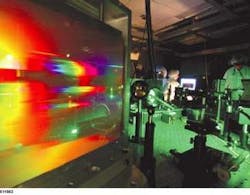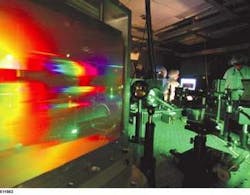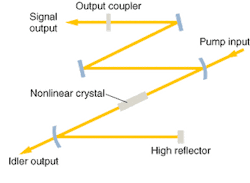Wide and smooth
Simple manipulations of the governing equations of nonlinear optics (NLO) often yield insight into new physical effects. Consider second-order effects that result from combining two beams of light at frequencies w1 and w2 to produce a new beam, that is:
ω1 + ω2 = ω3 (1)
For two incident beams with the same frequency, Equation 1 describes frequency doubling; the more general case is sum-frequency mixing. But when looked at it from right to left, this same equation represents another phenomenon: the generation of two lower-frequency beams from one intense incident beam, known as parametric conversion.
Borrowing terminology from radio engineering, parametric conversion describes the division of an incident pump beam into a "signal" and an "idler"
ωp + ωs = ωi (2)
The generation of the new beams is the result of second-order coefficients in dielectric crystals that lack certain symmetry properties. As with other NLO processes, the threshold for the onset of conversion is high, and for moderate pump powers the crystal must be placed inside a resonator. Such a device is called an optical parametric oscillator (OPO).
Great tuning
The phase-matching condition for parametric oscillation can be written as
npωp = nsωs + niωi (3)
where nλ is the index of refraction at the wavelength of the pump, signal, or idler beam in the nonlinear crystal. These indices depend on the temperature and angular orientation of the crystal. So, for a given pump beam, if the orientation or temperature of the crystal is changed, ws and wi must change, resulting in a broadly tunable output.
An OPO is not unlike a laser, but with amplification taking place in a nonlinear crystal. Tuning can be continuous over 1000 nm, and even more when the output is itself doubled or mixed. A tuning curve for the output of an OPO is shown in Fig. 1. By convention, the longer wavelength is designated as the idler beam.
Optical parametric oscillators differ from lasers in their sensitivity to pump beam characteristics. In a conventional laser, as long as the pump populates the upper states, the laser output by and large is independent of the character of the pump. An OPO however is extremely sensitive to the phase match between the three beams, and the pump beam must be collinear with the converted light in the crystal (noncollinear configurations do have some special uses).
If the OPO resonator is designed for resonance at the signal (or idler) wavelength, it is called singly resonant. Note that such devices still produce both signal and idler output (see Fig. 2). The OPO cavities can use both the signal and the idler beams to achieve threshold (doubly resonant), but these complex cavities must be resonant for both beams across their tuning ranges.
Into production
The introduction of OPOs for commercial use had to await the development of a crystal with a sufficiently high nonlinear coefficient, a high damage threshold, and wide spectral range for both transparency and phase matching. Beta barium borate (BBO), developed in the 1980s, is birefringent and transparent from 200 nm to 3.5 µm, and has a damage threshold of about 1 GW/cm2. Its introduction allowed the development of practical OPOs.
More recently different materials have been put to good use for parametric conversion—for example, to extend operation further into the infrared, or in some miniaturized, intracavity continuous-wave devices being developed for applications in telecom. Some conventional OPOs use lithium triborate (LBO) because its temperature-tuning property allows cavity stabilization by simply adjusting cavity length as the wavelength is tuned.
Because of the high threshold for OPO operation, current commercial systems are pulsed, available in either nanosecond or ultrafast (femtosecond or picosecond) pulse width. In nanosecond systems, the pump pulse is long compared to the round-trip time of the cavity, and so the pump beam will be present in the crystal when the signal pulse passes through. Ultrafast systems must use synchronous pumping, which times the arrival of a femtosecond or picosecond pump pulse at the OPO crystal to coincide with the circulating signal pulse.
Pumped by an injection-seeded neodymium laser, nanosecond systems are characterized by high pulse energies, good mode quality, and low divergence output. If the pump beam is frequency-tripled into the ultraviolet, the OPO output can extend through the entire visible spectrum into the near-infrared. Additional NLO crystals are often placed in the OPO to further extend this tuning range into the UV and out further into the IR.
Can't be too thin
To achieve very narrow linewidths, OPOs are configured as master oscillator/power oscillator systems (MOPOs) in which a small amount of the pump beam is first used to pump a master oscillator. This master oscillator uses a diffraction grating to help produce a spectrally narrow output that seeds the power oscillator. Such a system is capable of producing pulses with linewidths of less than 0.1 cm-1.
This narrow linewidth, combined with pulse energies on the order of a 100 mJ, is very useful for high-resolution spectroscopy. Many such experiments use two OPOs: one to produce a pump pulse tuned to the excitation wavelength of a molecule under study, and a second scanning device that probes the vibrationally or rotationally excited states that result.
When pumped by a modelocked Ti:sapphire laser, a synchronously pumped OPO can provide picosecond or femtosecond pulses at wavelengths from, say, 1.1 to 2.6 µm. Pump-probe experiments using the femtosecond output enable measurements that are orders of magnitude faster than possible using only electronic technology. This ultrafast output is of particular interest for spectroscopic studies of semiconductor materials.
Simpler but stronger
Another simple rearrangement of equation 1 provides a different view of the parametric process:
ω3 = ω2 - ω1 (4)
This describes "difference frequency mixing," which itself can be used to generate new wavelengths. As it applies to parametric conversion, power from a pump beam can be thought to amplify photons at the idler frequency to produce the signal beam ωs = ωp - ωi. In an OPO, the idler builds up from quantum noise present in the crystal.
The gain for this conversion, like other NLO effects, is a function of the pump power. With a short, intense input pulse, a single pass through an NLO crystal can convert a substantial fraction of the pump energy without the need for a resonator—the so-called optical parametric amplifier, or OPA. The idler wave in an OPA can be seeded by an external source, such as white light generated by a small fraction of the ultrafast pump pulses.
Like synchronously pumped OPOs, OPAs use Ti:sapphire pump sources to produce ultrafast output. Unlike OPOs, however, the Ti:sapphire pump beam typically is first amplified to milliJoule energies using chirped pulse amplification (CPA). The basic tuning range is similar to the OPO, but the high peak power allows additional high-efficiency NLO conversion from 200 nm out to as far as 20 µm. The final pulse widths are generally determined by the bandwidth of the pump and seed beams, but are also influenced by the properties of the OPA crystal.
A new seed
A new method of femtosecond-pulse generation for extreme peak power combines OPA and CPA technology. First proposed by researchers at the Rutherford Appleton Laboratory (Oxford, England), this new combination may allow such research facilities to increase the average power of their systems by more than an order of magnitude. Its initial appeal is its potential to significantly improve the signal to noise level of ultrafast experiments.
A critical component of CPA systems is a stable laser source with a broad spectral output. Existing systems rely on Ti:sapphire regenerative amplifiers for this source, because such devices have the broadest tuning range of any conventional laser. Chirped pulse amplification systems have widespread use in a wide variety of scientific disciplines, and in recent years have even migrated out of the laboratory to find applications in industrial environments.
However, problems can arise from the emission of both noise and pre-pulses from such systems. Prepulses result from a small amount of power that leaks from the regenerative amplifier prior to the emission of the main pulse. These prepulses can enter the main amplifier cavity ahead of each primary seed pulse. Even prepulses at only 10-3 times the amplified peak pulse from a terawatt-level system can cause serious problems at the target.
The main source of noise is spontaneous emission, present in all lasers, which also enters the main amplifier. The greater the amplified noise level compared to the main pulse, the less the signal-to-noise ratio in the measurement. Compared to Ti:sapphire seeded systems, single-pass OPCPAs reduce the amplified spontaneous emission by about an order of magnitude, and eliminate prepulses altogether.
In a Ti:sapphire regenerative amplifier, a pulse passes multiple times through the regenerative cavity, increasing in energy with each pass. The final amplification is often greater than 106. In an OPCPA system, the Ti:sapphire amplifier is replaced by an OPA. An OPA using two BBO crystals in series can produce the same energy gain with a single pass of the seed pulse.
Researchers are still working to develop a system that can take full advantage of the enormous bandwidth of the OPA output. Such a system could retain the brief tens-of-femtosecond pulse duration of an OPA, while increasing pulse energies well above the Joule level. This potentially could result in focused intensities of 1024 W/cm2 or higher.
On a more modest scale, hundreds of Ti:sapphire CPA systems are sold commercially every year. Such systems typically produce an average power in the neighborhood of 1 W. While these systems are sold almost exclusively for scientific applications, they have begun to generate interest for various forms of material processing. Most industrial applications , however, require a higher average power. The development of tabletop OPCPA systems could enable commercial femtosecond sources with average powers of tens or even hundreds of watts.
Next month's article begins the review of third-order nonlinear optical phenomena.



